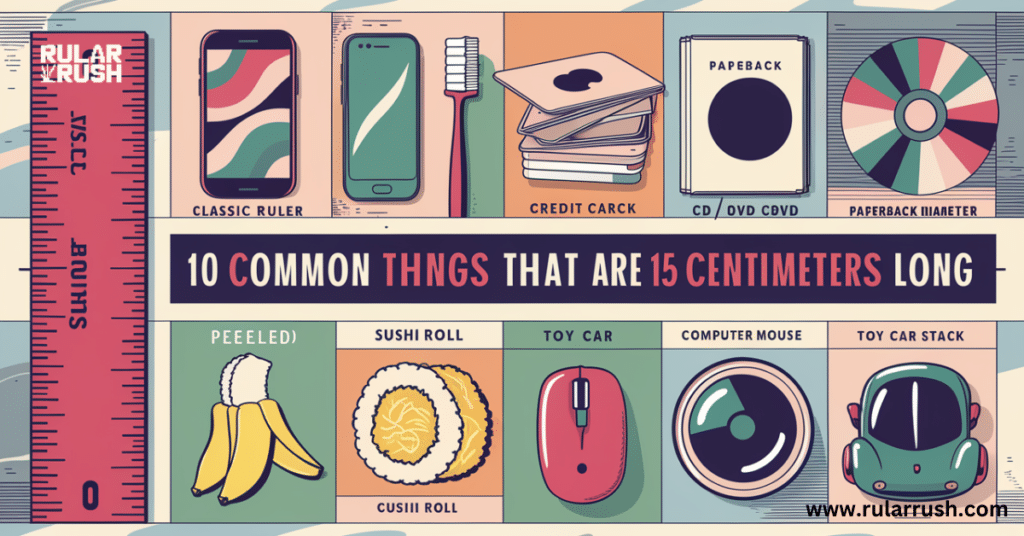
In a world where size matters, 15 centimeters might seem like an arbitrary measurement. But you’d be surprised how many common things are 15 centimeters long. This seemingly modest length plays a significant role in our daily lives, often without us even realizing it.
From the tools we use to the food we eat, objects that measure 15 cm are everywhere. Let’s dive into the fascinating world of these perfectly proportioned items and explore why this particular length is so prevalent.
Understanding 15 Centimeters
Before we delve into our list of things that are 15 cm, let’s get a grasp on what 15 centimeters really means. For those more familiar with imperial measurements, 15 centimeters is equivalent to about 5.9 inches. It’s roughly the width of an adult’s hand, from the outer edge of the palm to the tip of the thumb.
To help visualize measurements, consider this: if you were to line up 15 pennies edge to edge, they would stretch out to approximately 15 centimeters. This length of 15 centimeters is also about half the length of a standard 30-centimeter ruler.
A Brief History of the Metric System
The metric system, which gives us the centimeter, has an interesting history. It was first introduced in France in the late 18th century as a standardized system of measurement. The term “centimeter” literally means “one-hundredth of a meter.” The meter itself was originally defined as one ten-millionth of the distance from the North Pole to the Equator.
Today, the metric system is used by most countries worldwide, making it easier to understand and compare measurements across borders. This standardization is one reason why we see so many everyday objects 15 cm in length – it’s a convenient, internationally recognized measurement.
The Evolution of Measurement Standards
The journey to our current understanding of 15 centimeters is a fascinating one. Throughout history, humans have used various body parts and natural objects as references for measurement. For instance:
- Ancient Egyptians used the cubit, based on the length of the forearm
- The inch was originally based on the width of a thumb
- The foot, unsurprisingly, was derived from the length of a human foot
The shift to more standardized measurements like the centimeter was a crucial step in scientific and technological progress. It allowed for precise communication of measurements across different fields and cultures.
10 Surprising Objects Measuring 15 Centimeters
Now, let’s explore our list of items 15 cm long. You might be surprised by some of these common things 15 centimeters in length!
The Classic Ruler

When it comes to objects that measure 15 cm, the ruler is our go-to reference point. Many standard rulers are 15 centimeters long, making them perfect for quick measurements and comparisons.
Fun Fact: The first rulers were made of wood and date back to the ancient civilizations of Egypt and Mesopotamia. Today, rulers are manufactured using a variety of materials, including plastic, metal, and even flexible materials for specialized uses.
The Importance of Accurate Measurement Tools
Accurate measurement tools like the 15 cm ruler have played a crucial role in various fields:
- Architecture: Precise measurements ensure buildings are structurally sound and aesthetically pleasing.
- Engineering: Every component in machines and devices relies on exact measurements.
- Science: Accurate measurements are the foundation of scientific experiments and discoveries.
- Education: Learning to measure accurately is a fundamental skill taught in schools worldwide.
Smartphone Screen Diagonals

In the era of pocket-sized computers, many popular smartphone models sport screen diagonals measuring close to 15 centimeters. This 15 cm length has proven to be a sweet spot for balancing screen real estate with pocket-friendly portability.
| Smartphone Model | Screen Diagonal (cm) |
|---|---|
| iPhone 12 Mini | 13.7 |
| Samsung Galaxy S21 | 15.8 |
| Google Pixel 5 | 15.2 |
The size of a smartphone screen significantly impacts user experience. A 15 cm diagonal offers enough space for comfortable reading and video viewing while still allowing for one-handed operation for most users.
The Evolution of Smartphone Sizes

The journey to the 15 cm sweet spot for smartphone screens has been an interesting one:
- Early 2000s: Phones were small, with screens around 5-7 cm.
- Late 2000s: The first smartphones had screens around 8-10 cm.
- Early 2010s: Screen sizes grew rapidly, reaching 13-14 cm.
- Mid 2010s to present: Many flagship models settled around the 15 cm mark.
This evolution reflects changing user preferences and technological advancements, showcasing how the 15 cm length has become a standard in yet another aspect of our daily lives.
Standard Toothbrush

When it comes to dental hygiene, the toothbrush length of around 15 centimeters isn’t just a coincidence. This size has been carefully designed to provide optimal reach and control while brushing.
The ergonomics behind the 15 cm design take into account:
- The average size of human hands
- The depth of the oral cavity
- The need for maneuverability in tight spaces
Interestingly, toothbrush length can vary slightly in different cultures. For example, some Asian countries prefer slightly shorter toothbrushes, while North American designs tend to be on the longer side of the 15 cm spectrum.
The Science of Toothbrush Design
The 15 cm length of a standard toothbrush is the result of extensive research and development:
- Handle Length: The handle needs to be long enough to provide a comfortable grip and leverage for brushing.
- Head Size: The brush head should be small enough to reach all areas of the mouth but large enough to clean efficiently.
- Bristle Configuration: The arrangement and length of bristles are crucial for effective cleaning.
These factors combine to make the 15 cm toothbrush an effective tool for maintaining oral hygiene.
Credit Card Stack

Here’s a quirky 15 cm comparison: if you stack about 50 credit cards on top of each other, you’ll reach a height of approximately 15 centimeters. This fact might not seem particularly useful, but it does illustrate how thin yet sturdy modern credit cards are.
Brief History: The standard credit card dimensions (85.60 mm × 53.98 mm) were established by the ISO/IEC 7810 ID-1 standard in 1985. These dimensions allow cards to fit comfortably in wallets while providing enough space for essential information and magnetic strips or chips.
The Impact of Credit Card Dimensions
The standardized size of credit cards, which contributes to our 15 cm stack, has had far-reaching effects:
- Wallet Design: The dimensions of wallets and card holders are directly influenced by credit card sizes.
- Point of Sale Systems: Card readers and ATMs are designed to accommodate these standard-sized cards.
- Security Features: The consistent size allows for standardized security elements like holograms and chip placements.
This standardization showcases how a seemingly simple measurement can have widespread implications across various industries.
CD/DVD Diameter

Remember CDs and DVDs? These once-ubiquitous optical discs measure exactly 12 centimeters in diameter, which means their cases typically measure around 14-15 centimeters square.
Why this size? It’s said that the CD’s diameter was chosen to accommodate Beethoven’s Ninth Symphony, which runs for about 74 minutes. The compact disc needed to be large enough to store this amount of data while still being small enough to fit in car stereos and portable players.
While optical media is becoming less common in the age of streaming and digital downloads, the 15 cm case size remains a familiar sight in many homes and offices.
The Legacy of the 15 cm Optical Disc
Even as CDs and DVDs become less common, their influence remains:
- Data Storage: The capacity of a CD (about 700 MB) is still used as a reference point in data storage discussions.
- Audio Quality: The CD’s 44.1 kHz sample rate remains a standard in digital audio.
- Collectibility: Many music enthusiasts still value physical CDs, partly due to their familiar size and packaging.
The 15 cm CD case is a perfect example of how standardized measurements can become deeply ingrained in culture and technology.
Paperback Spine

Pick up your favorite paperback novel, and chances are its spine will measure close to 15 centimeters. This length of 15 centimeters is common for paperback spines, as it provides a good balance between portability and readability.
Book Thickness and Readability: The thickness of a book affects more than just its spine length. Thicker books can be harder to hold open, especially for extended periods. On the other hand, very thin books might feel flimsy or lack substance. The 15 cm spine often correlates with a book thickness that’s comfortable to hold and read.
The Art and Science of Book Design
The 15 cm spine length in paperbacks is not arbitrary. It’s the result of careful consideration of several factors:
- Ergonomics: A 15 cm spine fits comfortably in most hands, making it easy to hold the book for extended periods.
- Shelf Space: This size allows for efficient use of shelf space in bookstores and libraries.
- Printing Efficiency: Standard printing presses are often optimized for this size, reducing production costs.
- Reading Psychology: Studies have shown that readers find books of this size less intimidating and more approachable.
Banana (Peeled)

Nature, too, seems to favor the 15-centimeter length. A typical banana, when peeled, often measures around 15 centimeters. This size is not just coincidental; it’s the result of centuries of agricultural selection.
Nutritional Benefits of a 15 cm Banana:
- Contains about 110 calories
- Provides 450 mg of potassium
- Offers 3 grams of fiber
- Contains 15% of your daily vitamin C needs
Bananas of this size offer a perfect portion for a quick, healthy snack, making them one of the more delicious items 15 cm long.
The Science Behind Banana Size
The 15 cm length of a typical banana is the result of both natural evolution and human intervention:
- Wild Bananas: Originally, wild bananas were much smaller and filled with large seeds.
- Selective Breeding: Over thousands of years, farmers selected and bred banana plants that produced larger, seedless fruits.
- Optimal Growth: The 15 cm length represents an optimal size for the plant to support and for the fruit to reach maturity.
- Consumer Preference: This size has proven popular with consumers, influencing commercial growing practices.
Sushi Roll

Sushi lovers might be interested to know that a standard sushi roll often measures about 15 centimeters in length. This size allows for easy handling and a balanced ratio of ingredients.
Sushi Roll Sizes Around the World:
- Japan: Typically 8-10 cm
- Western Countries: Often 15 cm or longer
- “Jumbo” Rolls: Can exceed 20 cm
The size of a sushi roll affects more than just its appearance. It influences the balance of flavors and textures in each bite. A 15 cm roll often provides the perfect amount of fish, rice, and other ingredients in each piece.
The Art of Sushi Making
The 15 cm length of many sushi rolls is deeply rooted in the traditional art of sushi making:
- Rice Portioning: The amount of rice used in a roll is carefully measured to achieve the right balance with other ingredients.
- Nori Sheets: Standard nori (seaweed) sheets are sized to accommodate rolls of this length.
- Cutting Technique: The rolls are typically cut into 6-8 pieces, each around 2-2.5 cm wide, allowing for easy one-bite consumption.
- Presentation: The 15 cm length creates an aesthetically pleasing presentation on the plate.
Computer Mouse

The average computer mouse measures around 15 centimeters from front to back. This 15 cm length has been determined through extensive ergonomic studies to provide the best balance of comfort and control for most users.
Ergonomics of a 15 cm Mouse:
- Fits comfortably in the average adult hand
- Allows for precise cursor control
- Reduces strain on wrist and fingers during extended use
While mouse sizes can vary, many popular models cluster around the 15 cm mark. This size has proven to boost productivity by allowing users to work comfortably for longer periods.
The Evolution of Computer Mouse Design
The journey to the 15 cm computer mouse is a story of ergonomic evolution:
- Early Designs: The first computer mice were much smaller, often around 10 cm in length.
- Ergonomic Studies: As computer use became more prevalent, researchers began studying the impact of mouse design on user comfort and productivity.
- Size Increase: Mouse sizes gradually increased to better fit the human hand and reduce strain.
- Customization: Today, while 15 cm remains a common length, mice are available in various sizes to accommodate different hand sizes and grip styles.
Toy Car (1:24 scale)

For model car enthusiasts, the 1:24 scale is a popular choice, and many of these miniature vehicles measure close to 15 centimeters in length. This scale provides a good balance between detail and size, making the models easy to display and collect.
Popular Car Models at 1:24 Scale:
- Ford Mustang GT
- Chevrolet Camaro
- Porsche 911
- Lamborghini Aventador
- Toyota Supra
The 1:24 scale is widely used in the toy and model-making industry because it allows for intricate details while keeping the models at a manageable size. These 15 cm long replicas offer a tangible way to appreciate automotive design and engineering.
The World of Scale Modeling
The 1:24 scale, which often results in models around 15 cm long, is significant in the world of scale modeling:
- Historical Accuracy: This scale allows for highly detailed reproductions of historical vehicles.
- Manufacturing Precision: Modern manufacturing techniques can produce incredibly accurate 1:24 scale models.
- Collecting and Display: The 15 cm length is ideal for collecting and displaying multiple models without requiring excessive space.
- Educational Value: These models are often used in schools to teach principles of design, engineering, and history.
DIY 15 cm Measurement Tricks

Now that we’ve explored various objects that measure 15 cm, let’s look at some DIY methods to estimate this length without a ruler:
- Hand Span: For many adults, the distance from the tip of the thumb to the tip of the pinky finger, when the hand is fully spread, is close to 15 centimeters.
- Dollar Bill: A U.S. dollar bill is about 15.5 cm long, making it a handy reference point.
- Paper Folding: Take a standard A4 sheet of paper (21 cm x 29.7 cm). Fold it in half lengthwise, then fold this long strip into thirds. The resulting folded paper will be very close to 15 cm long.
- Smartphone: Many smartphones are close to 15 cm in length. Check your phone’s specifications to see how close it comes.
- Credit Cards: Three credit cards placed end to end will measure approximately 15 cm.
These tricks can be useful for quick estimations when you need to visualize measurements on the go.
The Importance of Estimation Skills
Being able to estimate measurements like 15 cm without tools is a valuable skill:
- Practical Problem Solving: It allows for quick decision-making in everyday situations.
- Spatial Awareness: Regular practice in estimation improves overall spatial awareness.
- Mathematical Thinking: Estimation is a fundamental mathematical skill that supports more advanced concepts.
- Creativity: The ability to use everyday objects for measurement fosters creative thinking.
The Significance of 15 Centimeters in Design
The prevalence of items 15 cm long in our daily lives is no accident. This length has proven to be particularly useful in design and manufacturing for several reasons:
- Ergonomics: 15 centimeters often aligns well with human body proportions, making it comfortable for handling and use.
- Portability: Objects of this size are generally easy to carry and store, fitting well in pockets, bags, and drawers.
- Manufacturing Efficiency: The 15 cm length allows for efficient use of materials and standardized production processes.
- Visual Appeal: This size often provides a pleasing aesthetic, neither too small to be insignificant nor too large to be cumbersome.
- Versatility: 15 centimeters is a length that works well for a wide range of applications, from writing instruments to electronic devices.
Understanding these design principles can give us a greater appreciation for the common things 15 centimeters in length that we encounter every day.
The Golden Ratio and 15 Centimeters
Interestingly, the 15-centimeter length often aligns closely with principles of aesthetically pleasing design, particularly the Golden Ratio. The Golden Ratio, approximately 1.618, is found throughout nature and is often used in art and architecture to create visually appealing proportions.
A 15 cm object, when divided according to the Golden Ratio, results in sections of about 9.3 cm and 5.7 cm. This proportion is often subconsciously pleasing to the human eye, which may contribute to the prevalence of 15 cm objects in our daily lives.
The Role of 15 Centimeters in Different Industries
The 15 cm length plays a significant role across various industries. Let’s explore how this measurement impacts different sectors:
In Technology
Beyond smartphones and computer mice, the 15 cm measurement is crucial in other areas of technology:
- Laptop Design: Many ultra-thin laptops aim for a thickness of around 1.5 cm (15 mm) when closed.
- Hard Drive Platters: Standard 3.5-inch hard drive platters measure about 15 cm in diameter.
- Circuit Board Manufacturing: Many standard PCB sizes are based on multiples or fractions of 15 cm.
In Food and Culinary Arts
We’ve mentioned bananas and sushi rolls, but the 15 cm measurement appears in other culinary contexts:
- Knife Blades: Many chef’s knives have blades close to 15 cm in length.
- Pasta Lengths: Some pasta types, like spaghetti, are often cut to approximately 15 cm before packaging.
- Cake Tiers: A common size for round cake tiers is 15 cm (6 inches) in diameter.
In Fashion and Textiles
The fashion industry also utilizes the 15 cm measurement:
- Zipper Lengths: 15 cm is a standard length for zippers in many garments.
- Fabric Swatches: Standard fabric swatches often measure 15 cm square.
- Scarf Widths: Many scarves are designed with a width of around 15 cm.
In Education
The 15 cm ruler is a staple in classrooms worldwide, serving as an introduction to measurement for young students. Its manageable size makes it ideal for learning basic measurement skills.
Cultural Variations in 15 cm Objects
While we’ve focused on common objects that measure 15 cm, it’s worth noting that cultural differences can affect how this length is used and perceived around the world.
In Japan
Japan’s culture of miniaturization often results in objects being slightly smaller than their Western counterparts. For example:
- Japanese notebooks often use the B5 size, which is about 18 cm x 25 cm, slightly smaller than the A4 size common in the West.
- Traditional Japanese carpentry uses a unit called the “sun,” which is about 3 cm. Five “sun” equal 15 cm, making this an important reference length in traditional crafts.
In Europe
The metric system originated in Europe, so 15 cm is a very familiar measurement:
- Many European countries use the A6 paper size (10.5 cm x 14.8 cm) for postcards, which is close to our 15 cm reference.
- In countries like Germany, there’s a strong emphasis on precision in manufacturing, often utilizing measurements in 5 cm increments, including 15 cm.
In North America
Despite using the imperial system officially, many industries in North America have adopted metric measurements:
- The 6-inch sub sandwich, a staple of fast-food chains, is actually advertised using its metric equivalent of 15 cm in many countries.
- In Canada, which uses the metric system, 15 cm is a common measurement in construction and woodworking.
The Future of 15 Centimeters
As we look to the future, how might the significance of the 15 cm measurement change?
In a Digital World
As more of our lives move into digital spaces, physical measurements like 15 cm might seem less relevant. However:
- Virtual Reality: VR and AR technologies often need to accurately represent real-world scales, keeping measurements like 15 cm relevant.
- 3D Printing: Home 3D printers often have print beds around 15 cm square, making this a common size for 3D-printed objects.
In Sustainability Efforts
As sustainability becomes more critical, the 15 cm measurement could play a role:
- Packaging Reduction: Standardized sizes like 15 cm can help optimize packaging and reduce waste.
- Modular Design: Future products might use standardized 15 cm modules for easy repair and recycling.
Conclusion
From rulers to smartphones, 15 centimeters long objects are integral to our daily lives. This exploration of things that are 15 cm unveils the thoughtful design behind everyday items. The ergonomic toothbrush and precisely sized sushi roll demonstrate the versatility of this measurement.
Next time you handle a pencil or banana, consider the impact of 15 centimeters. This small dimension significantly influences our interactions with the world. The ability to visualize measurements like 15 cm is valuable for DIY enthusiasts, students, and design appreciators alike.
When asked to imagine 15 centimeters, you now have a diverse array of everyday objects 15 cm in length to reference. From credit cards to computer mice, these items showcase how standardized measurements subtly shape our world.
In our global society, the 15 cm standard bridges cultures and industries. It’s a common thread in the fabric of our daily experiences, often operating behind the scenes.
As technology and culture evolve, so too will the role of this measurement. Yet, the humble 15 centimeters will likely continue to play an outsized role, reminding us that significant impacts often come in small packages.
Related Articles:https://rularrush.com/items-that-are-5-meters-long-big/

Elizabeth is an experienced blogger at “Rular Rush,” specializing in delivering precise and insightful content on various measurement topics. With a passion for simplifying complex concepts, she brings clarity and depth to each post, making technical information easy to understand for readers worldwide.






